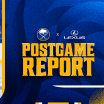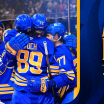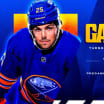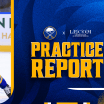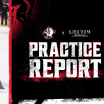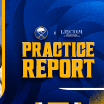As hands raised during a question and answer session with Sabres alumni Val James and Tony McKegney at Dipson Amherst Theatre on Feb. 15, Aaron Ray chose to forego a question and instead used the mic to tell his story.
Specifically, he wanted to thank McKegney.
Growing diversity spotlighted during HIFE month
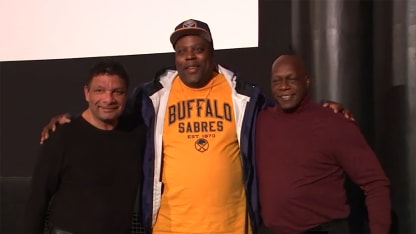
The theater had just finished screening Soul On Ice: Past, Present and Future, a documentary in which both James and McKegney are featured. In it, they describe the challenges they faced as black players in a predominantly white sport in the '70s and '80s.
Around that time, Ray was growing up as a black hockey player in Buffalo, which he said brought its own set of challenges. There was verbal abuse. There was, he believes, intent to injure him on the ice. One day, he says, he had finally had enough and was about quit playing altogether.
In a last-ditch act of desperation, Ray wrote to McKegney, who, at the time was one of Buffalo's top scorers. McKegney not only wrote back, he provided his home phone number for Ray to use when he needed to talk. He even left tickets at Will Call for him to attend games from time to time.
Now, some 30 years later, Ray looked over to McKegney and James and offered his appreciation.
"Those two are my idols, man," he said. "They were my idols growing up. Those two right there, man, those two kept me playing hockey."
After watching Soul On Ice, it's easy to understand why Ray related to the struggles McKegney faced on his path to the NHL. The film details the influence of black players throughout hockey's history, from the Colored Hockey League of Nova Scotia at the turn of the 19th century, to Willie O'Ree's breakthrough into the NHL in 1958 as the first black player, up to today.
The movie has been shown across NHL cities in February, a month that holds dual significance as both Black History Month in the United States and Canada and Hockey is for Everyone Month in the NHL. Buffalo's screening on Feb. 15 was sponsored by the Sabres, with proceeds benefiting Hasek's Heroes.
While a major mission of the film is to shed light on hockey's diverse history, it also points to a more diverse future for the sport.
Perseverance through adversity
James still remembers the first time his race was used against him on the ice. He was 13 years old, the same year he first learned to skate. Having grown up in a welcoming Long Island community, the "N-word" was something he had never really heard before, at least until a stranger came up to the glass and yelled it at him as he skated by.
"I was devastated," James said. "My whole warmup was ruined. I remember I wanted to cry and all of that stuff. I was really, really hurt."
He'd grow familiar with it as the years went on.
Soul On Ice shows a CBS report captured at a minor-league game in 1981 in Salem, Va., where a young white fan proudly mocked James by bringing a watermelon to the game, and chants of "Spook!" rang down from the crowd.
"In those days, I was alone," he said. "There was just a handful of us out there. It could get testy at times. There were a lot of people out there that figured if they threw around some racial names then it would throw you off your game, and I'm pretty much sure that was their intention.
"Of course you had people out there that their intention was bad, but of all the people out there, that may have been a quarter of the percent. It was a rough time in some buildings, but we got through it.
"I've got to be grateful and thankful that all the players and coaches that I played with were all good people and they made sure that anything like that didn't get out of hand."
McKegney has a similar story.
He had originally signed a contract to play for the Birmingham Bulls of the World Hockey Association as a rookie in 1978, but was forced to walk away from the deal when fans threatened to boycott the team for signing a black player. Instead, he joined the Sabres, who drafted him with the 32nd overall pick.
"The biggest thing I learned from those people is perseverance through adversity, and that's kind of the underlying theme of the film," Damon Kwame Mason, Soul On Ice's director, said.
"When I was doing research, I met a lot of guys that stopped playing hockey … I'd meet these guys, and the one thing that they would tell me is, 'I couldn't handle all the racism I was getting, all the racial epithets I was getting. I was just done with the game, I thought it wasn't worth it.'
"But then I'd meet guys like Val James, Tony McKegney, Georges Laraque and the Subbans. The thing they said was, 'Yeah, we would hear it, but I had to keep fighting.'"
James went on to become the first American-born black player to play in the NHL when he suited up for the Sabres during the 1981-82 season. He'd spend the majority of his career playing for the Rochester Americans in the AHL, with whom he won the Calder Cup in 1982-83.
McKegney, meanwhile, is referred to by Mason as the NHL's first black superstar. He played five seasons with Buffalo, recording 50 or more points four times, and posted 320 goals and 319 assists in an NHL career that spanned 13 seasons.
"To go forward you've got to know where you came from," Mason said. "Don't forget Tony McKegney. Don't forget Val James. What they went through, there were lessons learned. People became more tolerable. People saw what they went through and said, 'Oh my God, we can't let that happen anymore.'"
A diverse future
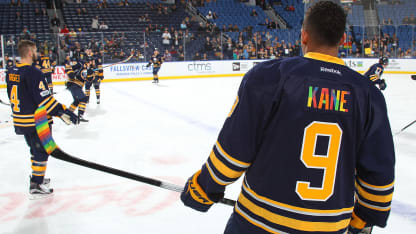
© Bill Wippert/Getty Images
In his film, Mason poses the question: How far is the NHL from seeing an all-black line? There's no question that the NHL is still a predominantly white league, but even a quick look at the Sabres roster shows evidence of a growing diversity.
Evander Kane and Kyle Okposo - Buffalo's top two goal scorers this season - are black, as are two of the organization's most dynamic young prospects in Justin Bailey and Nicholas Baptiste. Buffalo spent its third-round pick in last summer's draft on forward Cliff Pu, a Canadian-born forward whose parents moved from China with little money in their 20s.
"I might be an old man, but there's going to be a time when hockey is going to become very diverse," Mason said. "The game is not going to look like it does today.
"If you're in Toronto especially and you go to games on the weekends, it's black, white, Asian, East Indian. There's a gauntlet of kids and they're good. They're all good. It really excites me, not just for the young black athlete, but the young Korean athlete, the young Japanese athlete. It's coming. I tell people, 'It's coming, and you will see.'"
Kane, who fell in love with the game of hockey at a young age after watching his dad, Perry, play in his hometown Vancouver, echoed Mason's sentiment.
"I think you're seeing that more and more especially in minor hockey, all different types of athletes whether your East Indian, whether your Asian, whether your black, white it doesn't matter," Kane said. "It's a sport for everybody."
Hasek's Heroes, a program founded by Hall of Fame goaltender Dominik Hasek in 2001 to help bring hockey to economically disadvantaged children, operates with that mindset. It is the second-largest organization under the Hockey is for everyone umbrella, according to Director of Hockey Instruction & Rink Scheduling Ian Trudell.
The program operates rinks in Riverside and Cazenovia, providing underprivileged children with equipment, ice time and instruction at no cost.
"I think something like Hasek's Heroes is so important, because now you're introducing a group of kids to the game of hockey," Mason said. "Now, those kids may not become the next Evander Kane, but when they get to the age of Evander Kane and they have children, what's the sport you think they're going to put their kid in? It's going to be hockey."
Nick Smith, 21, became a part-time coach with Hasek's Heroes three years ago on the recommendation of former Sabre John Tucker, his coach with the Buffalo Junior Sabres. He joined with little knowledge of the program, but has since grown to forge strong relationships with many of the children and their families.
The father of one family Smith talked about had moved to Buffalo from India with very little knowledge of the game. His son, however, wanted to play so he was brought to Hasek's Heroes. The boy, Smith says, is one of the program's fastest skaters.
"His kid is a good hockey player," he said. "He has hockey instinct. That's something you can't teach."
But the program also isn't just about making good hockey players. For some kids, Smith says, it's an escape from everyday life. The instructors stress how the principles applied to the game of hockey can apply to life outside the rink.
"What we do is we get hockey equipment for the kids, teach them how to dress, get them out on the ice, get them some kind of a basic knowledge of the game," said James, who's done work with the program. "From that, we try to get them to realize that through discipline, hard work and executing things to the T is how you're going to be able to advance yourself through society."
As Hockey is for Everyone month comes to a close, racial diversity is just one of several topics touched upon by the League over the past 28 days.
All 30 clubs have held "You Can Play" nights, advocating for the inclusion and acceptance of LGBTQ athletes in sports, and Buffalo will celebrate women's hockey during Tuesday's game against the Nashville Predators.
Okposo, whose father is a native of Nigeria and whose mother hails from Minnesota, said that's really the whole point.
"I think it's good to make sure we're talking about being accepting, being including of everybody. At the end of the day, people are people," he said. "That's the biggest thing. Doing Hockey is for Everyone Month, it is for everybody. Whether you're black, white, brown, gay, bi, whatever. It doesn't matter.
"I think the world needs to be more accepting and I think the hockey community is changing with the world. I think we as people in the community need to be vocal in our acceptance of everybody and making it a comfortable place for people to come play."
After speaking with McKegney, Ray went on to play travel and high school hockey. He studied at Northern Michigan University, where he attempted to make the team captained by Danny Gare's brother, Morey, as a walk-on. He didn't make it, he says, but he cherishes the memory.
He remains a "die-hard" Sabres fan to this day, and looks at players like Okposo and Kane as modern-day examples for young players to look to and know there's room for diversity in the hockey, just as he once looked at Tony McKegney and Val James.
"We had Mike Grier before, we had Grant Fuhr … I've always been a fan," Ray said. "It's always good when you're watching to see somebody that's just like you."

